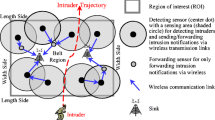Abstract
When a sensor network is deployed to detect objects penetrating a protected region, it is not necessary to have every point in the deployment region covered by a sensor. It is enough if the penetrating objects are detected at some point in their trajectory. If a sensor network guarantees that every penetrating object will be detected by two distinct sensors at the same time somewhere in this area, we say that the network provides double barrier coverage (DBC). In this paper, we propose a new planar structure of Sparse Delaunay Triangulation (SparseDT), and prove some elaborate attributes of it. We develop theoretical foundations for double barrier coverage, and propose efficient algorithms with NS2 simulator using which one can activate the necessary sensors to guarantee double barrier coverage while the other sensors go to sleep. The upper and lower bounds of number of active nodes are determined, and we show that high-speed target will be detected efficiently with this configuration.
Similar content being viewed by others
Explore related subjects
Discover the latest articles, news and stories from top researchers in related subjects.References
Meguerdichian S, Koushanfar F, Potkonjak M, Srivastava M B. Coverage problems in wireless ad-hoc sensor networks. In Proc. INFOCOM, vol.3, Anchorage, Alaska, USA, 2001, pp.1380–1387.
Meguerdichian S, Koushanfar F, Qu G, Potkonjak M. Exposure in wireless ad-hoc sensor networks. In Proc. MOBICOM, Rome, Italy, 2001, pp.139–150.
Liu B, Towsley D. On the coverage and detectability of wireless sensor networks. In Proc. WiOpt’03: Modeling and Optimization in Mobile, Ad Hoc and Wireless Networks, Sophia-Antipolis, France, 2003.
Thai M T, Wang F, Du Ding-Zhu. Coverage problems in wireless sensor networks: Designs and analysis. International Journal of Sensor Networks, Special Issue on Coverage Problems in Sensor Networks, 2006, accepted.
Kumar S, Lai T H, Arora A. Barrier coverage with wireless sensors. In Proc. MOBICOM, Porta, T L, Lindemann C, Belding-Royer E M, Lu S (eds.), ACM, 2005, pp.284–298.
Li Xiang-Yang, Calinescu G, Wan P J. Distributed construction of planar spanner and routing for ad hoc wireless networks. In Proc. INFOCOM, New York, USA, 2002, pp.1268–1277.
Li Xiang-Yang, Stojmenovic I, Wang Y. Partial Delaunay triangulation and degree limited localized bluetooth scatternet formation. IEEE Trans. Parallel Distrib. Syst., 2004, 15(4): 350–361.
Xing Guoliang, Lu Chenyang, Pless R, Huang Qingfeng. Impact of sensing coverage on greedy geographic routing algorithms. IEEE Trans. Parallel Distrib. Syst., 2006, 17(4): 348–360.
Araújo F, Rodrigues L. Fast localized Delaunay triangulation. In Proc. OPODIS, Grenoble, France, LNCS 3544, Higashino T (ed.), Springer, 2004 pp.81–93.
Guibas L J, Knuth D E, Sharir M. Randomized incremental construction of Delaunay and Voronoi diagrams. Algorithmica, 1992, 7: 381–413, also In Proc. 17th Int. Colloq. Automata, Languages and Programming, Warwick University, England, LNCS 443, Springer-Verlag, 1990, pp.414–431.
Sack J, Urrutia G (eds.). Voronoi Diagrams. Handbook of Computational Geometry. Elsevier Science Publishing, 2000.
Kumar S, Lai T H, Balogh J. On k-coverage in a mostly sleeping sensor network. In Proc. MOBICOM, Haas Z J, Das S R, Jain R (eds.), ACM, 2004, pp.144–158.
Author information
Authors and Affiliations
Corresponding author
Additional information
This paper is supported by the National Grand Fundamental Research 973 Program of China under Grant No. 2006CB303006.
Electronic Supplementary Material
Below is the link to the electronic supplementary material.
Rights and permissions
About this article
Cite this article
Jiang, CD., Chen, GL. Double Barrier Coverage in Dense Sensor Networks. J. Comput. Sci. Technol. 23, 154–165 (2008). https://doi.org/10.1007/s11390-008-9113-3
Received:
Revised:
Published:
Issue Date:
DOI: https://doi.org/10.1007/s11390-008-9113-3




